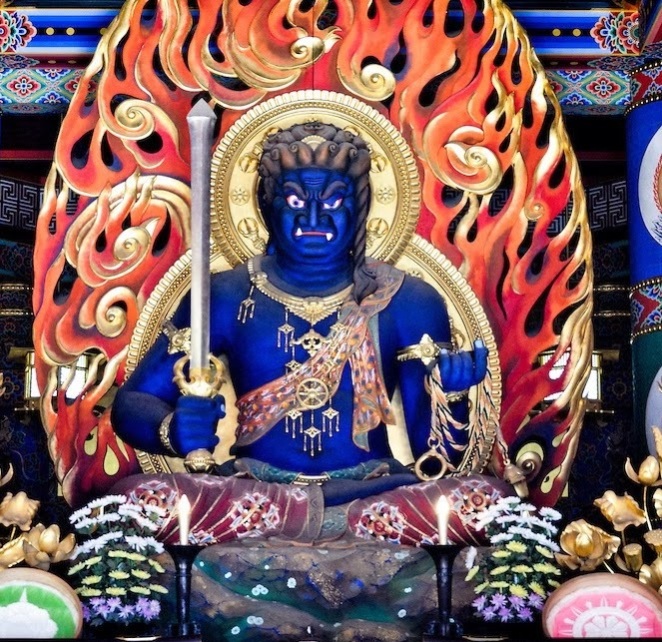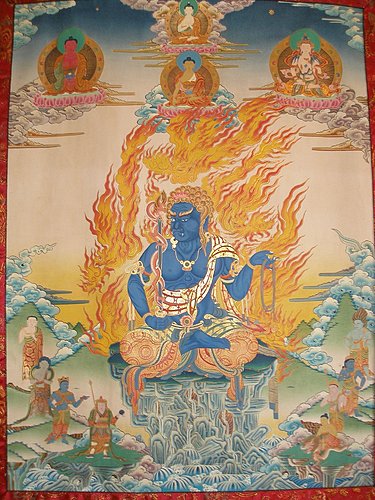Arya Achala, Tibet 12th century, Kadampa school. Originally the Mahayana deity Acalanātha,whose name means “immovable protector”, Acala was incorporated into Vajrayana Buddhism as a servant of the Buddha. Ācala is also the name of the eighth of the ten completion stages of the Bodhisattva path (the Eighth Bhumi). His siddham seed-syllabe is “hāṃ”. He is one of the Krodharajas, the Lords of Wrath.He is the guardian of Buddhism and one of the five Wisdom kings along with Gōzanze, Gundari, Daiitoku and Kongōyasha. As such, he is the central figure and when the Five Wisdom Kings are represented together, he usually is in the middle.
In Tangmi (Tang-era Chinese Vajrayana), his name was translated as Budong “immovable” (Chinese: 不動; pinyin: Búdòng, Middle Chinese: /pǝw dungx/).
In turn, the deity was imported into Japan as “Wisdom King Acala” (不動 Fūdō) by the priest Kūkai (died 835) who was studying in China as a member of the Kentoshi mission and founded the Shingon Buddhism. Scholars such as Miyeko Murase state the origins of this Buddhist deity are in the Hindu god Shiva, particularly his attributes of destruction and reincarnation.
Fudō Myō-ō is the central deity in all Myō-ō groupings, and in artwork is positioned in the center. Fudō is a personification of Dainichi Nyorai, and the best known of the Myō-ō, who are venerated especially by the Shingon sect of Japanese Esoteric Buddhism (Mikkyō 密教). Fudō converts anger into salvation; has furious, glaring face, as Fudō seeks to frighten people into accepting the teachings of Dainichi Buddha; carries “kurikara” or devil-subduing sword in right hand (representing wisdom cutting through ignorance); holds rope in left hand (to catch and bind up demons); often has third eye in forehead (all-seeing); often seated or standing on rock (because Fudō is “immovable” in his faith). Fudō is also worshipped as a deity who can bring monetary fortune.
Also, Fudō’s left eye is often closed, and the teeth bite the upper lip; alternatively, Fudō is shown with two fangs, one pointing upward and other pointing downward. Fudō’s aureole is typically the flames of fire, which according to Buddhist lore, represent the purification of the mind by the burning away of all material desoires. In some Japanese sculpture, Fudō is flanked by two attendants, Kongara Dōji and Seitaka Dōji. In artwork, Fudō is often accompanied by Eight Great Youths. Fudō is also one of the 13 Deities 十三仏 (Jūsanbutsu) of the Shingon Sect in Japan. In this role, Fudō presides over the memorial service held on the 7th day following one’s death.
Myō-ō is the Japanese term for Sanskrit “Vidyaraja,” a group of warlike and wrathful deities known in English as the Mantra Kings, the Wisdom Kings, or the Knowledge Kings. Myō-ō statues appear ferocious and menacing, with threatening postures and faces designed to subdue evil and frighten unbelievers into accepting Buddhist law. They represent the luminescent wisdom of Buddhism, protect the Buddhist teachings, remove all obstacles to enlightenment, and force evil to surrender.
Introduced to Japan in 9th century, the Myō-ō were originally Hindu deities that were adopted into Esoteric Buddhism to vanquish blind craving. They serve and protect the various Buddha, especially Dainichi Buddha. In most traditions, they are considered emanations of Dainichi Buddha, and represent Dainichi’s wrath against evil and ignorance. In Japan, among the individual Myō-ō, Fudō is the most widely venerated.
The deity has been popular throughout the Middle Ages and into modern times in Nepal, Tibet and Japan, where sculptural and pictorial representations of him are most often found. Much of the iconography comes from Japan.
In Tibetan Buddhism and art, the buddha Akshobhya, whose name also means “the immovable one”, presides over the clan of deities to which Ācala belongs. Other sources refer to the Acala and Caṇḍaroṣaṇa as an “emanation” of Akshobhya, suggesting further assimilation.
He evolves into a deity invoked in Buddhist rituals to “frighten gods, titans, men and destroy the strength of demons”, and he slays all ghosts and evil spirits.In some Buddhist texts such as Sadhanamala, the Hindu gods Vishnu, Shiva, Brahma and Kandarpa (god of love) are said to be “wicked” because they cause the endless rebirths, and these gods are terrified of Acala because he carries a rope to bind them. In others, such as Mahavairocana-sutra, one dedicated to Buddha is instructed to visualize the left foot of Acala on his head during meditation, to prevent obstacles in his reaching Prajna (insights).
In the Nepalese and Tibetan Buddhist tradition, Vishvavajri becomes Acala’s consort.
He is seen as a protector and aide in attaining goals, efficacious in overcoming disease, poison and fire, conquering enemies and tempters, and bringing wealth and peace to his devotees.

His statue can be seen in so many places in Japan that it’s not uncommon to find one near a waterfall or simply by a mountain path.
In the martial arts the character “shin,” meaning spirit, heart or will, is often added to the root “fudo” to become “fudoshin,” a term meaning calm spirit, even when faced with danger, without fear or confusion, that does not dwell or become fixed on anything. This was the highest attainment of spiritual skill only attainable when the mind is totally focused on the totality of sensory input and free of thoughts and emotions – detached but aware and present. A related term “mushin” also is often used to mean “without mind” (not occupied by thought or emotion).
Using the “fudo” root, other related terms include “fudo-chi,” meaning immovable spirit or wisdom that can’t be influenced, or confused, “fudotai” or immovable body, and “fudoshise” or immovable stance and “fudo-dachi” or “immovable stance” also sometimes referred to as a “preparation stance” (as in the initial and final stance in kata, one that allows the participant freedom of movement and action in any direction).
Iconography
Fudo Myo-o, a Japanese deity (also know as Acala), the God of Fire.He is considered as a body of metamorphosis (Nirmanakaya) of Vairocana Buddha, a fierce God of Indian origin although neither a Buddha nor Bodhisattva. A male, he is usually portrayed as livid blue in color with a terrible facial expression standing or sitting on a rock surrounded by flames. He also often has a third eye, representing his capacity to see all. Finally, his hair is braided on the side of his head in the manner of a servant to represent his service to all sentient beings.
They represent the burning of anger and passion to purify the mind. He usually stands or sits on a rock which represents his determination to stay where he stands (his immovability). Fudô Myo-o holds a rope in his left hand, used to catch and bind demons
and a sword called “Kurikara” or devil-subduing sword to, well, you guessed it, subdue the demons. It is also used to cut through ignorance.
His face is contorted in anger, his eyebrows elevated and his mouth grimacing menacingly. He usually has two fangs protruding from his mouth: one pointing upwards (represents the strength of his desire to progress upward in his service for the Truth) and the other one pointing downward (represents his unlimited compassion for those suffering in body and spirit).
Mantra
This is the mantra of Fudo-san:
のうまく さんまんだ ばざらだん せんだ まかろしゃだ そわたや うん たらた かんまん
Nômaku sanmanda bazaradan senda makaroshada sowataya un tarata kanman.
(In Japanese)
Namah samanta-vajrânâm canda mahârosana sphotaya hûm trat hâm mâm (In
Sanskrit.)


